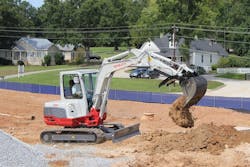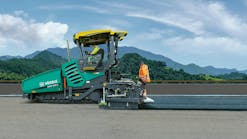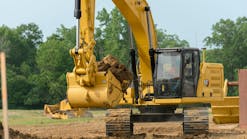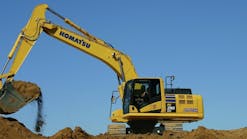Manufacturers have also increased attachment capabilities and offerings, and begun the march toward Tier 4-Final. The mini excavator category has evolved into a “jack of all trades,” even replacing the ubiquitous backhoe for some tasks.
Mini excavator evolution
“Machines have evolved so much in the past few years,” says Mark Wall, product marketing manager for John Deere and Hitachi excavators. “They’ve gone from your basic ‘Here’s your machine, it’s got a canopy on it, one arm, one bucket choice, go dig a hole’ to rivaling the big machines in features, benefits and comfort.
“They’ve got a cab, and air conditioning, auto shifting from high to low, proportional auxiliary hydraulics, pattern changers, suspension seats, multiple arm options and we’ve also got a coupler on ours,” Wall says.
Well over a dozen manufacturers crowd the category. According to Wall, the largest and most popular segment is the 3.5-metric-ton class, with most manufacturers adding offerings up to the 6-ton area. “Our largest is 6 metric tons and it digs 13 feet deep, which is about what a backhoe would do; you didn’t see that years ago,” he says.
“The last five years have shown a significant increase in the variety of excavators in this size class,” says Katie Pullen, brand marketing manager, Case Construction Equipment. “Zero tail swing models remain in high demand, but we’re also seeing customers find advantages in more traditional, conventional swing excavators. The greatest driver in the size class is the versatility of the equipment. Any number of attachments or features can be added to diversify the capabilities of that machine, making it extremely valuable.”
Hydraulic thumbs and hammers are the most popular attachments for the category.
“The hydraulic thumb is one of the most highly sought after attachments you can put on these things,” Wall says. “It goes back to the ability to place things. They can pick up landscape boulders and place them. You can put a hammer on them and bust up a concrete sidewalk, then use the thumb to put them in the back of a truck for disposal.”
Attachments are but one reason for the category’s growth.
“The reason we’ve seen so much growth is due to the benefits of a specialized digging machine,” says Adam Purcell, Wacker Neuson’s product manager for excavators and job site dumpers.
“The machines are significantly more efficient, not only than many larger excavators, but also some of the alternative methods of digging, like a backhoe,” he says.
With 360-degree rotation, the ability to work in one lane of traffic, backfill blades to help fill trenches in tight spaces, and low ground pressure to keep from destroying all the material around you just to dig a 6-foot hole, the advantages of mini’s add up.
“The trend in the last 10 years and pushing forward, is really right-sizing the machine for the application where you get the best ROI possible,” Purcell says. “Your acquisition cost is what it should be—and your operating cost is in line with what you can charge for, let’s say, digging a residential basement.”
Rent or own?
“(Mini excavators) are a high-volume product for our rental partners,” Pullen says. “We continue to see growth potential in both the 3- to 4-metric-ton size class and the 5- to 6-metric ton size class.”
Indeed, many managers’ first foray into the category came through rental. Mini excavators remain popular rental items, but what’s the best approach?
“If you look at a grand trend over the last 15 years, the percentage of rental has decreased as a whole and the percentage of ownership has increased as a whole,” Wall says. “Contractors have understood that they can own the asset and increase utilization, and make it more profitable to own rather than rent. Rental is still a big portion of compact excavators, but it’s not as big as it used to be; it’s a smaller piece of the pie.”
In the near-term, however, rental has gained in popularity while some users wait for the recovery to gain more traction.
“From everything we hear, the rental market overall is up,” says Purcell. “From a contractor’s perspective, if you’re not sure what you’re going to be doing two years from now, you rent and you have the cash flow without the big commitment to the new machine. I think you’re seeing rental up and retail becoming a smaller portion, although we estimate right now it’s 50-50.”
The recovery isn’t the only situation giving managers pause, Purcell says.
Possible Tier 4-F effect
“I think in regard to the Tier 4-Final transition, there are some unknowns from a product standpoint—the horsepower and the amount of electronics inside the machine are changing,” Purcell says.
“Owners who typically worked on their own machine in the past might be a little apprehensive about what they’re still going to be able to do. Some guys are worried; until the new technology has been in the market a while, it’s not tried and true, so it’s easier to say ‘I’ll rent this machine for maybe 18 months and see what I think before I commit to that purchase,’” he says.
There is also a trend toward manufacturers increasing the number of models they offer. Caterpillar, for example, has expanded its offering in the smaller end (less than 3 metric tons) of the range in the last year, now offering six models instead of three and adapting the features and benefits of larger models in its line, including a hydraulic lockout lever, blade float, attachment-ready hydraulic lines and a quick disconnect feature.
With Kobelco’s re-entry into the North American market as an independent brand after a 10-year dalliance with CNH, it is adding four models to the category; from the 15.2-horsepower SK17SR to the 39-horsepower SK55SRx. Dozer blades are standard on each model.
The playing field among OEMs is becoming fairly even, feature-wise, but there are still some differences. Wacker’s Vertical Digging System compensates for operation on uneven terrain by leveling the house and setting the operator in an upright position on slopes up to 15 degrees. “If you’re on a 15-degree slope and using the full 15-degree tilt function, you save 25 percent not only in time, but you’re also digging 25 percent less material and creating 25 percent less backfill,” Purcell says. “You’re digging more efficiently to get to your trench depth.”
But will the category “roll?”
“There will be a continued evolution of these machines to be more like larger machines,” Deere’s Wall says. “You’ll see a continued refinement of compact machines to make them operate, look, feel, and have the same serviceability of a 20-ton machine.”
In addition to these small machines adopting even more big-machine features, there may be a couple of other key developments to note.
At least one manufacturer in North America is betting that wheeled excavators are going to make a splash in the 6-metric-ton-and-below category. Wacker offers a wheeled model, the 6-ton 6503.
“You get the mobility that you’ve had with a backhoe, but you get the convenience and the digging capabilities of an excavator,” Wacker Neuson’s Purcell says.
“It will take time, but I think wheeled excavators will absolutely be a growth trend for the overall industry,” he continues. “I like to think we’ll capture the early adopters. The market has really settled on the 3- to 4-ton class. It’s really 40 percent plus of the overall sales, and the 6-ton 6503 is basically the brother machine to the 6003, our 6-ton tracked, so we think we’re targeting the larger percentage of the market with the convenience of a machine that drives 19 mph.
“There are a lot of mobility benefits for municipalities and contractors in major cities where you don’t or can’t deal with a truck and trailer; getting it into the tight areas. We’re going after the heart of the mini excavator market with backhoe-type mobility,” Purcell says.





